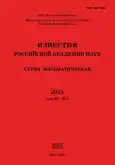卷 88, 编号 5 (2024)
Articles
Models of representations for classical series of Lie algebras
摘要
 3-46
3-46


Finite abelian subgroups in the groups of birational and bimeromorphic selfmaps
摘要
 47-66
47-66


Nuttall decomposition of a three-sheeted torus
摘要
 67-126
67-126


Local analog of the Deligne–Riemann–Roch isomorphism for line bundles in relative dimension 1
摘要
We prove a local analog of the Deligne–Riemann–Roch isomorphism in the case of line bundles and relative dimension $1$. This local analog consists in computation of the class of $12$th power of the determinant central extension of a group ind-scheme $\mathcal G$ by the multiplicative group scheme over $\mathbb Q$ via the product of $2$-cocyles in the second cohomology group. These $2$-cocycles are the compositions of the Contou-Carrère symbol with the $\cup$-product of $1$-cocycles. The group ind-scheme $\mathcal{G}$ represents the functor which assigns to every commutative ring $A$ the group that is the semidirect product of the group $A((t))^*$ of invertible elements of $A((t))$ and the group of continuous $A$-automorphisms of $A$-algebra $A((t))$. The determinant central extension naturally acts on the determinant line bundle on the moduli stack of geometric data (proper quintets). A proper quintet is a collection of a proper family of curves over $\operatorname{Spec} A$, a line bundle on this family, a section of this family, a relative formal parameter at the section, a formal trivialization of the bundle at the section that satisfy further conditions.
 127-173
127-173


Pfister forms and a conjecture due to Colliot–Thelène in the mixed characteristic case
摘要
 174-186
174-186


Inverse problems for evolutionary quasi-variational hemivariational inequalities with application to mixed boundary value problems
摘要
The aim of this paper is to examine an inverse problem of parameter identification in an evolutionary quasi-variational hemivariational inequality in infinite dimensional reflexive Banach spaces. First, the solvability and compactness of the solution set to the inequality are established by employing a fixed point argument and tools of non-linear analysis. Then, general existence and compactness results for the inverse problem have been proved. Finally, we illustrate the applicability of the results in the study of an identification problem for an initial-boundary value problem of parabolic type with mixed multivalued and non-monotone boundary conditions and a state constraint.
 187-210
187-210










